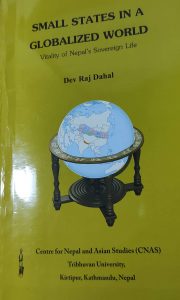Dev Raj Dahal
Senior Political Scientist, Nepal

The post-war geopolitical order defined exclusively by the Western rules, institutions and processes is now fraying with the acceleration of a shift of power and wealth to Asia called by scholars “Easternization which is transforming politics in the world beyond Asia” (Rachman, 2017:3). The unstoppable rise of China perceived as a major competitor of the US in security strategy, economy technology, connectivity, vaccination and races for space stations. T U.S.-China ties face an unhappy pass as the former sees the latter a strategic competitor seeking to revise the rules of the international system game. The fierce crisis tendencies of many states of the world big and small and the surge of alliances and counter alliances have driven geopolitics to a fundamental shift and resurrected nationalism all over the world as a self-defense mechanism. They have challenged the policies of reckless, brakeless and borderless globalization.
Nepal new geopolitics presumes to cultivate national interests, in an inter subjective frame, not only based on the geographic determination foreign policy. It has allowed the free flow of ideas, goods and people that characterized globalization. But it is cautious about its effects national security, social cohesion, economic progress and political stability to avoid being a loser in the winner-takes-all market game and adopted welfare state policies. “Geopolitics involves alliances, and with the world order currently in a state of flux, this is the time whe the big powers need small powers on their side as well as vice versa (Marshall, 2021: xiii).

The smaller, weaker states, workers, peasants and marginalized populations are expressing an “instinct of self-protection” (Wallerstein 1991:230) against the aftereffects of globalization considering that is founded on inequality and polarization at every level of governance. As a result, geopolitics “is now being played against a setting globalization, every crisis interacts in some way with every other one the world is increasingly claustrophobic” (Kaplan, 2017: 16).
The global structure of power spurred polycentrism. It has created certain options for stable small states while triggered internal fissures in others making their politics disorderly. It has imposed critical barriers to evolve stable cooperation, development and peace. Globalization has also set off multilateralization of international relations without fostering multilateralism, a healthy deference for the interest of every nation. It requires a great measure of compatibility, a complex admixture of both cooperation and competition. No institution or power is capable of dictating and enforcing international law to control what Hedley Bull calls the “anarchical international system.” The regulation of anarchy is possible only through the art of civilization, a powerful global Leviathan or, a global polity capable of assuming global responsibility of transforming international law into a cosmopolitan constitution” and “complete constitutionalization of international relations” (Habermas, 2005: 143) governing human rights, global justice and equitable distribution of global common goods. The navigation of multi-lateral problem-solving in this world of complex interdependence requires “a steering group that recognizes the interconnections of topics and connects new and existing machinery among governments to solve problems” Zoellick.
2009:48).
Not even the U.S. though its previous leadership had turned back from global consensus on climate change, annulled the Trans-Pacific Partnership, showed reluctance to negotiate Doha round of global tariff reductions at WTO by focusing on America first protectionist policy to restore its greatness, decoupling from China, weakening alliance commitments and straining relations with Russia, Iran, Turkey and Europe. These policies have encouraged the “US allies and partners to advance their national security, prosperity and wellbeing through increased autonomy“(Patrick, 2017: 57). The deliberate retreat of the U.
S. from global leadership prompted other states and regions- Japan, South Korea, the UK, European Union (EU), Association of Southeast Nations, India and China to defend globalization as its beneficiaries and adapted their policies to secure a semblance of global governance for the protection of global common good. The Regional Comprehensive Partnership (RCEP) set up in November 2020 is a free trade agreement between Asia-Pacific nations, including China. It aims to facilitate the expansion of trade and investment and contributes to global economic growth and development.
The new US leadership of President Joe Biden is improving trust to promote the geopolitical advantage of working with Group of Seven (G-7), North Atlantic Treaty Organization (NATO), the EU and seeking united front of democratic nations in support of liberal multilateral regimes. It is lending health and infrastructural support to developing countries while considering the evolution of the Sino-Russian axis and Russia-Iran-Syria axis as a challenge for its global leadership. The US Defense Secretary Lloyd Austin recently declared to confront China for its potential military threat to Asia in its pursuit of hypersonic weapons intended to evade the US missile defense system, unfair trading practices and creating unequal playing field through state subsidies to Chinese companies. The Chinese leadership, however, views the US holding of the “Summit of Democracy” barring it, Russia and Iran not for global solidarity and cooperation but pushback of its initiatives. China since the older times views Asia its sphere of influence and believes that the US is trying to check its rise as a global power and opposes its diplomatic boycott of the 2022 Being Winter Olympics.
The Sino-US trade until October 2021 stood $64.67 billion and both the nations are struggling to bargain to adapt to new interdependence.
The Sino-Russian pivot represents geopolitically a colossal landmass that dominates the heartland of the “Eurasian world island to use the concept of Halford Mackinder. The pivot area is “defined in terms of a zone not accessible to sea power and is surrounded by an inner crescent in mainland Europe and Asia and an outer crescent in the island and continents beyond Eurasia” (Taylor, 1988: 18). By its sheer gargantuan size, resources and political will Russia is now shoring up its strength to assume global role and increasing its outreach beyond its traditional backyard.
Yet, it is frightened from the US policy of NATO’s expansion in Georgia and Ukraine and democracy promotion, forwarded its own version of Euro-Atlantic security system and sought guarantee from the USA for its national security. Since the Russian annexation of Crimean Peninsula from Ukraine in 2004 its tie with the West have been strained. The US diplomat Antony Blinker in December 2021 warned a resurgent and self-confident Russia against invading Ukraine as Moscow told Kiev that any attempt to retake Crimea amounted to a direct threat to its security. Moscow has demanded that NATO deny membership to Ukraine and other former Soviet republics and rollback the alliance’s military buildup in Central and Eastern Europe.
The US and EU perceive Russia a declining hegemonic power without the capacity to dominate Asia and Europe. Yet, they perceive that China is operating under the logic of balance of power like the USA and indulged in security competition, evolving China-centric world order, developing its blue water navy, projecting its power in South China Sea, Indian Ocean and the Pacific and seeking to restore old glory (Kaplan, 2014:20-21 and 148) They, however, perceive that China is not a threat to Europe and the Persian Gulf and, therefore, they are enlarging profitable trade and development cooperation with it. The evolution of new polarity shaped by the U.S.-India-Japan-Australia coalition and deeper level of Russia-China strategic partnership strongly influences world politics in general and the Asian geopolitics in particular. The realism of geopolitical competition of great powers is even trickling up to the Arctic and the space, not only confined to rebalancing, containment, encirclement, alliance and deterrence in Asia.

India’s policy until recently was to maintain “strategic autonomy” between the U.S. and China, uphold its independent position for the reason of its own great power aspiration and maintain affinity with Russia, a close partner of China, rather than act as a strategic counterweight. The U.S. favored India in its border clashes with China in Galwan but Russia seemed neutral between India and China. New Delhi and Washington “have signed Basic Exchange of Cooperation Agreement (BECA), Logistics Exchange Memorandum Agreement (LEMOA) and the Communication Compatibility and Security Agreement (COMCASA), sealing a framework of mutual trust and long term military and strategic cooperation against China” (Roy, 2020). The Russia-US ties are mutually exclusive while the former is in good humor with Germany for growing cooperation on energy and shows an active presence in South Asia, Gulf, Africa and Latin America. The growing economic cooperation between India and China is likely to pacify their unpleasant ties compelling both to seek interdependent choices beyond US-India strategic partnership. The Indian purchase of S-400 from Russia for air defense indicates its disinclination to become America’s subordinate partner and play the role of a democratic counterweight to Sino-Russian strategic league. Still, the states’ conduct cannot be seen in isolation from the ties with the other extra-regional powers gravitational pull and societal forces operating in solidarity for reasons of attributional affinity of soft power. “Democracies feel closer to each other than they do to non-democratic states” (Henrikson, 2002:437).
China’s peaceful ascent has set three trends: adjustment of many nations to its initiatives, open to it but without flouting interaction with other powers and actively engaging in the U.S.-led China containment scheme to uphold the Asian status quo. The revisionist Chinese power provided the four nations—US, Japan, India and Australia-am opportunity to set a strategic background to forge an alliance to shape Quadrilateral Security Dialogue (QUAD) in 2007 and Australia, the UK and the US (AUKUS) security pact in 2021 to counterbalance China’s military and economic clout in the Indo-Pacific region, South China sea and the Indian Ocean. It also sets an ideological framework to sustain liberal international order and a conceptual frame even for New Zealand, South Korea and Sino-phobic Vietnam to join it. For reasons of geographical proximity with China the latter two have abstained from joining.
The evolution of QUAD considered by China an Asian version of NATO, however, is less projected as a full-fledged military alliance with joint strategic defense to increase collective leverage and support the American shifting policy focus on the Himalayas and the Asia-Pacific region.
End of First part:
Text courtesy: Excerpts from the recently published book, (2022) “Small States in a Globalised World”, by Centre for Nepal and Asian Studies (CNAS), Tribhuvan University, Kirtipur, Kathmandu, Nepal.
# The entire editorial board of the telegraphnepal.com is highly indebted to the senior political scientist of Nepal, Professor Dev Raj Dahal and the Executive Director of the CNAS Dr. Mrigendra Bahadur Karki.
# published in the larger interest of the global audience: Chief Ed.
Our contact email address is: editor.telegraphnepal@gmail.com
